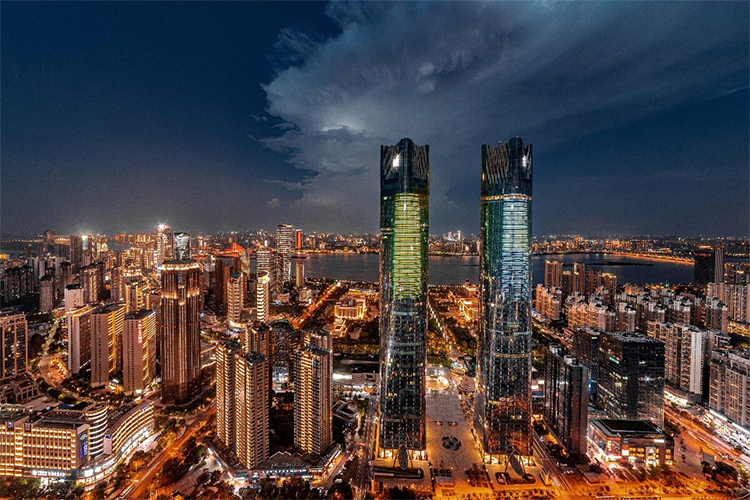Nanchang Twin Towers LED Light Show: 303m Jiangxi Skyline Spectacle
Introduction
When night falls, the 303-meter Nanchang Twin Towers cast brilliant reflections on the Ganjiang River. Flowing LED lights bloom the city flower—gold-edged daphne (jinbian ruixiang)—across the night sky. More than Jiangxi’s tallest building, the Twin Towers act as a vertical urban culture pavilion. As the twin stars of Honggutan CBD, their glass facades and high-tech silhouette tell the story of Nanchang’s leap from the ancient Yuzhang commandery to a modern metropolis.
1. Landmark Sketch: Jiangxi’s “Skyward Parlor”
Called “the towers that lift the future on the gold-edged daphne,” this award-winning pair (China Construction Engineering Luban Prize) has redefined Nanchang’s skyline since completion in 2015. The East Tower houses Fortune Global 500 companies; the West Tower hides the Pluris Hotel’s sky lobby. In 420,000 square meters of space, business leaders, travelers, and city explorers converge. For the best experience, visit at sunset: when the sun gilds Ganjiang Bridge, the full-glass observation levels deliver a 270-degree “Cloud Nanchang” panorama.
2. Architectural Code: When the City Flower Meets Steel
The twin design hides three layers of intent:
– City-flower totem: the rooftop profiles borrow the layered petal texture of the gold-edged daphne; night lighting often morphs into local symbols like the Tengwang Pavilion silhouette or blue-and-white porcelain patterns.
– Intelligent skin: unitized glass curtain walls use double-silver Low-E coatings to keep transparency while cutting energy use by about 30%.
– Vertical city: 72 high-speed elevators reach the top in roughly 45 seconds; 78 floors include panoramic sky corridors (check ahead—some corridors may be closed to the public).
3. Must-Do Experiences
| Light & Shadow Art |
The LED light show runs Fridays and Saturdays, 19:30–21:30. The best viewpoint is across the river at Qiushui Square; drone footage from there is spectacular.
| Cloud Dining |
A·ONE restaurant on the West Tower’s 53rd floor is Jiangxi’s highest dining venue. Try the “Ganpo Cloud Banquet,” sampling Poyang Lake silverfish soup at nearly 300 meters.
| Cultural Creations |
Basement B1’s Yuzhang Impression Hall collects Jiangxi intangible heritage. You can try Nanchang ceramic panel painting (reservation required) and take home an LED-lit “dynamic Tengwang Pavilion” model.

4. Practical Guide
Time planning
– Day (10:00–17:00): Explore B1–B2 retail areas and taste Jiangxi specialties.
– Dusk (17:30–19:00): Ascend for sunset—allow 30 minutes for security lines.
– Night (after 19:30): Light show period; Ganjiang Park nearby often runs synchronized music fountain performances.
Local tips
– East Tower’s ground-floor free viewing platform exists, but the paid hotel observation deck (128 CNY, approx. US$18) offers a superior view.
– Avoid Monday light-show maintenance days. During the rainy season, high-altitude visibility can be reduced by clouds and fog.
Transport
Take Metro Line 1 to Qiushui Square Station, Exit 5, then walk about 8 minutes along Ganjiang Middle Avenue. Drivers can park in B3 parking (first hour 10 CNY).
5. Suggested Day Itinerary
Link the Twin Towers with nearby highlights:
Morning: Haifenghou Kingdom Ruins Museum (about 40 minutes by car) → Lunch: classic restaurant near Tengwang Pavilion → Afternoon: Nanchang Uprising Memorial Hall → Dusk to Night: Twin Towers observation + Ganjiang River cruise.

Conclusion
On these glass walls at Jiangxi’s apex you’ll see both the classical image of Wang Bo’s “rosy clouds and lone wild geese” and the pulsing digital heartbeat of a VR industry hub. From 300 meters above the Ganjiang, Nanchang’s dialogue between past and present becomes vividly legible.


